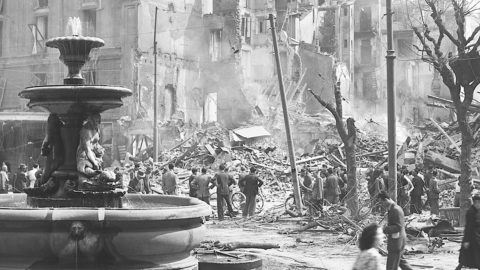Galleries of Italy – Piazza Scala, the Intesa Sanpaolo museum in Milan, opens to the public 9 22 from October to November the exhibition "BUT WE WILL REBUILD. Milan bombed in 1943 in the Publifoto Intesa Sanpaolo Archive". Among over 3.300 photographs in the Publifoto Archive depicting Milan bombed during the Second World War, Mario Calabresi, curator of the exhibition, has selected 70 images of eleven symbolic places of the city – including the Last Supper, the Galleria Vittorio Emanuele, Sant'Ambrogio, Brera, the State University and Piazza Fontana – devastated by the air attacks of 1943. The images show the face of a city destroyed but at the same time courageous, crucial shots that depict its pride and ability to be reborn. With the historical testimony of such dramatic events, the exhibition aims, despite the great difference of origins, situations and effects compared to that historical period, to be a stimulus to the current restart of the city.
“Much has been destroyed, but we will rebuild everything with patience and with the most trusting will”. The words of Antonio Greppi, the first mayor of Milan after the Liberation, are the most beautiful and moving manifesto of the tenacious hope of the Milanese. "The story of men who believe only in their own virtues and works and who consider freedom as the inescapable continuation of the conscious fulfillment of one's duties begins anew".
The historical documents are accompanied by shots of the same places taken during the lockdown by the Turin photographer Daniele Ratti. The pandemic has turned people's daily lives upside down and Mayor Greppi's words can once again ring with encouragement. The exhibition is enriched by the contribution of Umberto Gentiloni, historian and academic of the La Sapienza University of Rome, on the strategy decided by the Allies to strike the country to definitively overthrow Fascism in August 1943, a few days after the fall of Mussolini, and a map of the city indicating the places most affected by the bombings.
The exhibition is the first appointment of the project 'Journey to the Publifoto Archive of Intesa Sanpaolo' which intends to open the photographic heritage to the availability of the public. The Publifoto Intesa Sanpaolo Archive, purchased by the Bank in 2015, is today a heritage of around seven million analogue photographs, mostly in black and white, of news, politics, customs, society, culture, sport, landscape and architecture, made between the 13s and 1472s in Italy and abroad, both by the operators of the famous Italian photojournalism agency, and by photographers or other agencies that used Publifoto for distribution. It is part of the Intesa Sanpaolo Group Historical Archive which, with over 2006 linear km of documents, represents one of the main primary sources of economic history in Europe, with maps, images, objects, videos whose chronological extremes range from 1984 to 2022. Born in XNUMX as the Historical Archive of the Banca Commerciale Italiana, today it coordinates the safeguarding and enhancement interventions, in the pertinent territories, of the historical archives of the banks merged into Intesa Sanpaolo and actively collaborates with the most important archival networks and institutions. Intesa Sanpaolo's photographic collections will be fully exploited in the fourth headquarters of the Gallerie d'Italia, which will soon open in Piazza San Carlo in Turin (XNUMX).
John Bazoli, President Emeritus of Intesa Sanpaolo, states: «The historical documents of the Publifoto Archive chosen by Mario Calabresi and the current photographs show us a Milan which, seriously injured, does not give up and works for the reconstruction. Yesterday as today Intesa Sanpaolo confirms its commitment to making culture an engine of renewal for the city and for the entire country. The research and enhancement projects of historical roots go in this direction, thanks to the use of the Publifoto Archive, a precious heritage of collective memory. "
Mario Calabresi, curator of the exhibition, declares: “The Publifoto Archive is a wonderful container of memories of the twentieth century, capable of showing us the strength with which we got back on our feet many times. At a time when Milan and Italy are facing a new challenge, not from bombs and fire but from a silent and invisible enemy, reminding us of what we have faced and overcome must give us back the tenacity of hope".





